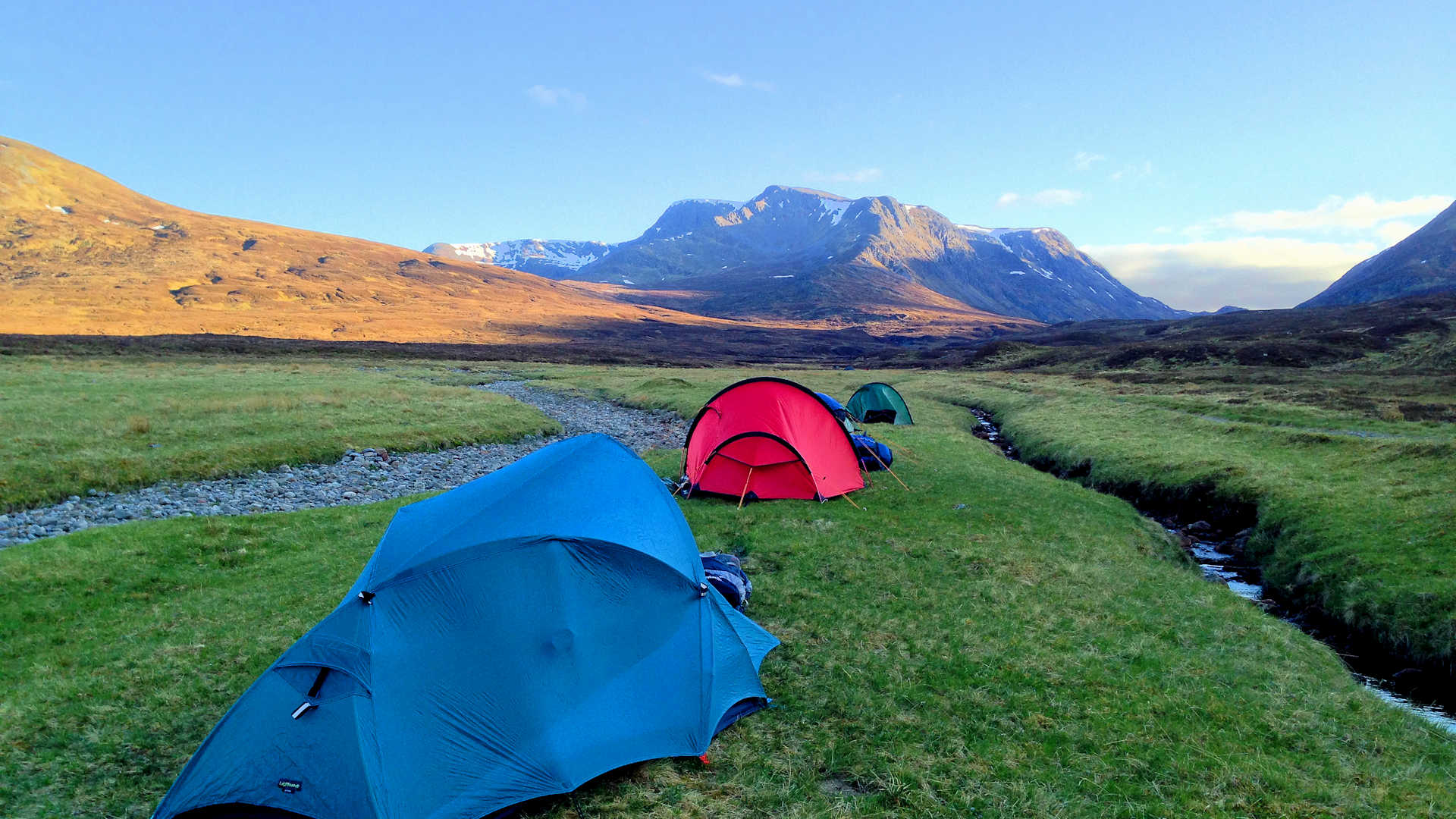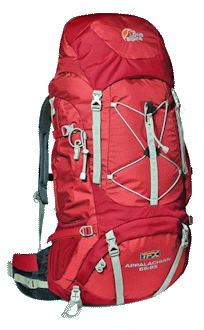
Backpacking gear
Gear for backpacking into Scottish wilderness
Below are some hints and advice to help you get the most enjoyment out of backpacking into remote areas of Scotland. Try to keep the weight you're carrying down to under 20% of your body weight, so try and find lightweight equipment.Tent
Backpacking or 'wild camping' tents come in a variety of shapes, sizes, materials and prices. Choosing a backpacking tent can seem daunting at first !
Ideally your tent should consist of a separate inner and flysheet and have a porch area.

Size and weight
Go for a 2-man tent, that way you'll be able to sleep in comfort and store your gear out of the rain. Smaller 1-man tents are just a bit too tight for overnight camping in Scotland ! Go as lightweight as your budget will allow, ideally keeping the weight to under 2kg.Flysheet
The flysheet is the outer layer of the tent. Most likely this will be made of ripstop nylon, though cheaper tent flysheets can be made of polyester. The flysheet waterproof effectiveness can be measured by looking at the 'hydrostatic head rating' - the greater the number, the better performance. Look for a gap where the flysheet gets close to the ground - smaller gaps will keep more rain out, bigger gaps will reduce inside condensation.Inner tent
Inner tents keep occupants from the condensation on the inner of the flysheet and from midgies (and other crawly beasties). Some mesh net will be needed, but too much mesh and the tent will feel draughty. Check the material on the base of the inner-tent is sturdy enough for its likely use - you may opt to buy an additional footprint groundsheet.Porch
The porch area is the gap at the entrance to the tent where you'll most likely be cooking and storing gear. A porch that is too small area could mean you'll be storing your gear outside the tent.Poles
Look for backpacking tents with poles made of metal alloy. Avoid poles made of fibreglass (found in cheaper budget tents) as these are heavier and weaker than alloy poles and can split in cold weather. The sections of poles in backpacking tents will be linked with a shock-cord to make assembly easier.Pitching
Tents can either be pitched 'inner-first' or 'outer-first'. Inner-first pitched tents tend to be more stable and save weight. Tents that are pitched outer-first are better suited if pitching in the wet as the inner can be protected from rain.Price
Generally, the more you pay, the better quality and lighter tent you'll buy. You can get budget backpacking tents from around £50 upwards from the likes of Coleman, Highlander and Kathmandu. Vango, Alpkit and Wild Country make fine backpacking tents for around £150. The more expensive brands are the likes of Terra Nova, Hilleberg and Mountain Hardware.Sleeping bag
Sleeping bags come in a variety of construction materials, shapes and temperature ratings. Choosing the appropriate one will be mainly dependent what time of year you'll be backpacking and the weather conditions you're expecting.

Season
Sleeping bags can be quoted with a 'season rating', usually a number from 1 to 4, but bags for very cold conditions can be given a '5'. For backpacking in Scotland outwith winter, go for a 3 season sleeping bag.Temperature limit
Sleeping bags can have up to three temperature limits quoted - 'comfort', 'comfort limit' and 'extreme'. The 'comfort' figure is the temperature at which an average person can sleep comfortably and the 'comfort limit' is the temperature at which an average person can sleep without waking in a curled position. The 'extreme' figure is the temperature at which you'll be very cold but won't die !Down vs Synthetic
Down is often quoted as a ratio of down to feathers, the higher the ratio, the better the quality and higher price. 90/10 is good with 70/30 more common in cheaper bags. Synthetic fillings are almost as efficient as down and have the advantage of coping better with wet.Weight and size
The heavier the sleeping bag, the more likely it is to be warmer, however you'll need to lugg it ! Check the expected pack down size as space in your rucksack will be at a premium. The shape of the bag will affect the weight - a trimmed 'mummy' bag with baffles is an ideal compromise. £100 should get you a quality 3 season bag weighing under 1.5kg. Have a look at Sleeping Bags Outlet for a range of bags at good prices !Sleeping mat
Invest in a sleeping mat to insulate you and your sleeping bag from the ground. A simple 'roll-mat' will be cheap to buy and light, but bulky and not much comfort. 'Self inflating' mats are more expensive and fairly bulky but inflate quickly and insulate well. A lightweight air mat will take up the least space in your rucksack and insulate almost as well as a 'self inflating' mat, though it will take effort to blow up.Cooking and eating
For cooking and eating you'll need a stove, some cookwear, utensils and food !

Stove
Stoves come in various forms, typically fueled by butane/propane, methylated spirits or paraffin. Personally I prefer the butane/propane stoves that screw into a cartridge - clean and no hassle, though the only downside is as the cartridge empties, the flame intensity drops off. Don't forget some kind of lighter !Cookset
If you're cooking in windy conditions, a windshield is recommended. Go for a lightweight solo cookset and try to fit the stove inside along with lighter and pad with a J-cloth for cleaning. A 'spork' is probably the only utensil you'll need !Food
Dried, carb rich and quick cook food is the stuff to go for, eg noodles or cous-cous. It doesn't have to be fancy mountain designed food, Super Noodles, Mug Shots and Cup-A-Soups are great ! Think of the calories you'll be burning and need to replace over the days you're backpacking and hiking over the hills. I also always pack a few treats for those wet days !Rucksack
What kind of rucksack are you going to carry all your backpacking equipment in ? How heavy should it be and what volume should it be able to hold ?

Volume
A backpacking rucksack needs to hold between 60-80 litres. There are various types of rucksack, look for ones described as 'expedition' sacks. If you're backpacking into a base, then hiking from there, you may consider carrying a day-sack, or ensure your backpacking rucksack has adjustable compression straps.Comfort and stability
Your backpacking rucksack should have an adjustable back-height, padded hip-belt and compression straps on the external pockets. To minimise backstrain and aid stability, pack with weight close to frame and light stuff nearer bottom and on the outer side. Items that need frequently accessed should be packed near the top whereas your sleeping bag should be stuffed into the bottom of your backpacking rucksack in the lower separate compartment.Waterproofness
Rucksacks are never completely waterproof (although the Ortleib brand claim to be and we'll be testing this out), so pack items that need to stay dry (eg your sleeping bag and next day's clothes) in kayak-bags.Other gear
You'll need spare clothing and a down jacket. I like a clean pair of socks and underwear for each day on the hills ! Even if you don't use walking poles, take a set - you'll find they aid stability over long walks with heavy sacks. A large flexible water container is prefered to rigid aluminium ones.
Hiking gear for Spring to Autumn »
Winter gear »




